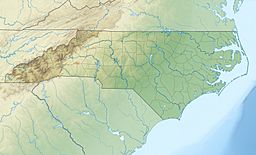Lake Glenville facts for kids
Quick facts for kids Lake Glenville |
|
|---|---|
| Thorpe Reservoir | |
| Location | Jackson County, North Carolina, United States |
| Coordinates | 35°11′46″N 083°09′11″W / 35.19611°N 83.15306°W |
| Type | reservoir |
| Basin countries | United States |
| Surface area | 1,470 acres (5.9 km2) |
| Max. depth | more than 130 ft (40 m) |
| Shore length1 | 26 mi (42 km) |
| Surface elevation | 3,494 ft (1,065 m) |
| Settlements | Cashiers, Glenville |
| 1 Shore length is not a well-defined measure. | |
Lake Glenville is a large reservoir in North Carolina. A reservoir is a man-made lake that stores water. It is located about 8 miles from Cashiers, North Carolina. The lake was created in 1941 by building a dam on the west fork of the Tuckasegee River.
From 1951 to 2002, the lake was officially called "Thorpe Reservoir". This name honored J. E. S. Thorpe, who was the first president of Nantahala Power. You might still see this name on some older maps. Lake Glenville is very deep. The bottom drops sharply, and it can be more than 80 feet (24 m) deep close to the shore. The lake has about 26 miles (42 km) of shoreline and covers 1,450 acres. It is also a short drive from Western Carolina University.
History of Lake Glenville
During World War II, a company called ALCOA (Aluminum Company of America) needed a lot more electricity. They used this electricity to make aluminum, which was important for the war effort. To get more power, Nantahala Power and Light, which ALCOA owned, started building a dam.
In June 1940, they began building the dam on the west fork of the Tuckasegee River. They finished the dam in late 1941. This dam created the new lake, which was called Thorpe Reservoir or what we now know as Lake Glenville. The lake filled the entire valley north of Cashiers. Because of this, the town of Hamburg had to be moved. The old town, including its schools, homes, businesses, and farms, was flooded by the new lake.



